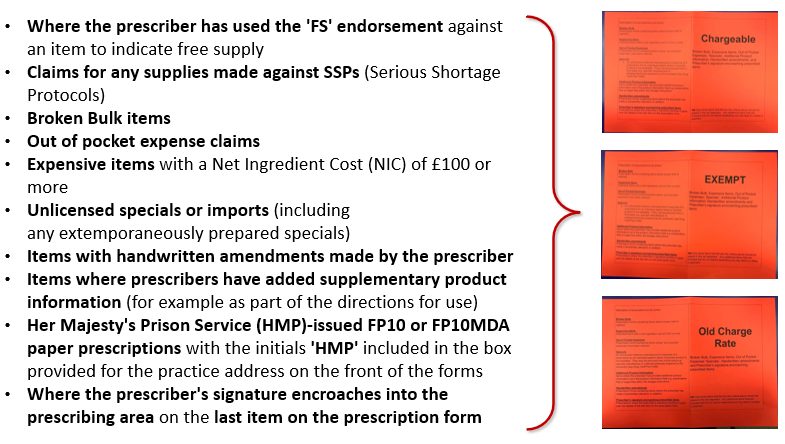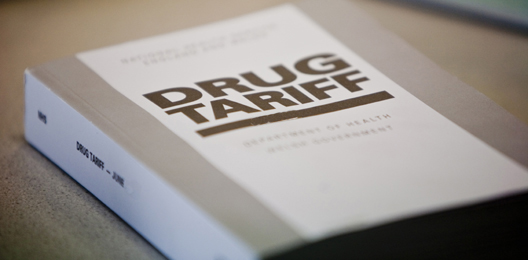Red Separators – end of month submission
Published on: 21st October 2021 | Updated on: 4th November 2022
This page outlines the inclusion criteria for red separators for submission to the NHS Business Services Authority (NHSBSA) as part of your monthly prescription bundle. We also highlight the importance of using the red separators and explain how to safely secure any forms included in the red separators to ensure that they do not become loose during transit.
Pharmacy teams are able to download our Guidance on the use of red separators for end of month submission factsheet for more information.
The NHSBSA issues contractors with three sets of red separators each month to sort certain types of paper prescription forms into their relevant exempt, paid or old charge rate groups. Only certain prescription forms that meet the criteria set out below should be included in the red separators.
The image below shows the different types of prescriptions that should be placed in the red separators.
Prescription forms containing the following are required to be placed into red separators:
Contractors should note that from October 2021, the Department of Health and Social Care (DHSC) has agreed to add Bulk prescriptions for schools or institutions and paper FP10 or FP10MDA prescriptions issued to prisoners on release by Her Majesty’s Prison Service (HMP) to the list of forms/items to be included in the red separator for exempt prescriptions for end of month submission. The prescription sorting and submission guidance outlined in the digital (MYS) FP34C submission forms has been updated to reflect this change to the red separator inclusion criteria. People who have just been released from prison do not have to pay for NHS prescriptions. Additionally, prescription charges are also not payable in respect on Bulk prescriptions issued for schools or institutions. However, there is no specific exemption declaration for patients or their representatives to select on the reverse of paper prescription forms to declare an exemption reason for Bulk or HMP Service-issued prescriptions. Placing Bulk and HMP Service-issued prescriptions in the exempt red separator will ensure that these forms are subjected to additional checks by operators at the NHSBSA avoiding the risk of contractors having any incorrect prescription charge deductions applied to any items issued on these forms. Any unsorted forms will continue to be processed for payment by the NHSBSA but will bypass their additional checking processes. If, however, a patient presenting a HMP form is exempt from prescription charges for other reasons, he/she should continue to select the relevant exemption reason and sign the reverse of the form before placing it with other exempt prescriptions in the exempt bundle. HMP Service-issued paper FP10 or FP10MDA forms are issued to prisoners who are recently released from prison so they can get their prescription items for free until they arrange to see their GP or register with a new GP. To be classed as exempt, the prescription must have the initials ‘HMP’ included in the box for the practice address at the front of the prescription form. The ‘HMP’ initials allows dispensers and the NHSBSA to identify the prescription issued to prisoners on release. Placing these forms in the exempt red separator will ensure that operators at the NHSBSA can recognise and process HMP Service-issued prescriptions as exempt from prescription charges. The following information is usually included in the practice address box on the front of the HMP Service-issued FP10 or FP10MDA prescriptions: Note: Currently only paper forms are issued to HMP prisoner. EPS is currently out of scope for this group of patients despite an EPS exemption category 0015 ‘Was prescribed free-of-charge HMP/prisoners/persons detained in other secure accommodation medication’ available for the processing of prescriptions for prisoners on release. Bulk prescriptions can be identified by the front part of the form containing the name of the school or institution rather than the patient’s name. The Drug Tariff Part VIIIA Clause 9 states ‘A “Bulk” prescription is an order for two or more patients, bearing the name of a school or institution in which at least 20 persons normally reside, for the treatment of at least 10 of whom a particular doctor is responsible. Such a prescription must be an order for a drug which is prescribable under the NHS and which is not designated a “Prescription Only Medicine” (POM) under Section 58(1) of the Medicines Act 1968, or for a prescribable dressing which does not contain a product which is designated POM.’ Instead of printing ‘red’ separators on white paper from the Manage Your Service (MYS) portal, Community Pharmacy England advises contractors to use the actual red separators posted out by the NHSBSA each month. Eligible forms (following criteria above) should be wrapped in their applicable red separators (exempt, paid or old charge rate) and placed at the top of the remaining prescription bundle before it is despatched to the NHSBSA. The NHSBSA recommends the use of elastic bands to secure prescriptions for submission. If, however, a small number of forms are to be submitted using a red separator, then a paper clip may be used to secure the prescriptions to ensure that they do not come loose from the separators during transit. There are no virtual red separators for EPS prescriptions. Prescriptions that would ordinarily be placed in a red separator are processed accordingly, when submitted electronically. However, The log or PMR report should then be used to reconcile items/values against the pharmacy’s FP34 Schedule of Payments or Prescription Item (Px) reports after a bundle has been priced. If you are unable to, or unsure how to generate a report which incorporates the above, please contact your PMR system supplier for further support.
Community Pharmacy England does recommend that for the purposes of prescription reconciliation, contractors should keep a log or generate report(s) from their PMR system for the following types of
items submitted for payment:
Useful links
For more information on the changes to the end of month prescription sorting requirements see our page Prescription submission requirements.
For guidance on sorting paper prescriptions with old charge rates that meet red separator criteria see our story Correct submission of forms and items paid at the old charge rate.












